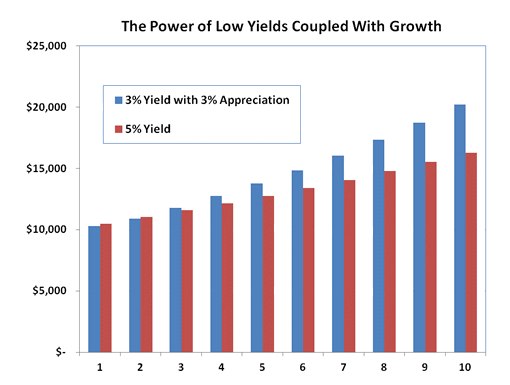They're some of the most overlooked income investments. I'm willing to bet that nine out of 10 investors don't even consider them when they're buying an income stock...
That's a shame because if you know what to look for, these securities can be some of the most powerful portfolio builders around.
I'm talking about investing in stocks with low dividend yields. I know, it might seem counterintuitive, but sometimes lower-yielding stocks can be better than their high-yield counterparts.
Don't believe me? Consider two stocks, one that pays 5% and another that yields 3%. It seems like a no-brainer to go with the stock that is yielding 5%.
However, if that low-yield stock can appreciate just 3% a year -- while maintaining its 3% yield -- it can outperform a static 5% yielding stock in just three year's time. In ten years, you can double your money with the low-yielding -- but growing -- security.

And if you can find a security with a little higher yield or a slightly higher growth rate, it gets even better.
Of course, in order to achieve results like these, you need to find stocks that have the ability to consistently grow year in and year out... and, at the same time, keep up with their dividend payments.
Finding those stocks is easier said than done. However, if you look for these four things, then you could substantially increase your chances of finding the market's best low-yielders.
These traits only take about two minutes to look for, but they could lead you to one of the best income investments you've ever made...
1. A Dividend Track Record
The best indication a stock can maintain its dividend is if it has a history of raising it. When a company steadily increases its dividend for years, chances are it has a commitment to its dividend policy and a willingness to share its growing income with shareholders.
In other words, if a company is raising its dividend now, it is unlikely to be stingy in the near future.
2. A Low Payout Ratio
When looking for the market's best dividend payers, it's imperative to look at a company's payout ratio. The payout ratio measures the percentage of a company's earnings it pays out in dividends. For instance, if a company earns $.75 per share in a quarter and pays a $0.25 per share dividend, its payout ratio is 33% ($0.25/$0.75).
While there is no exact rule of thumb, a lower payout ratio indicates that a company has more income that it could dedicate to dividends. A high payout ratio indicates that the company may already be paying out all that it can afford.
3. Revenue Growth
This one is pretty much self-explanatory.
In order for a company to continue to grow and maintain its dividend, then it needs to continue to increase its top line. Show me a company that is selling more goods and services, and I'll show you a stock that has the potential to appreciate.
4. A Compelling Story for Future Growth
The past and present are good guideposts for selecting a low-yielding stock with appreciation potential. But the day you buy a stock, the future is what's key.
In order to really be a successful dividend stock, the company has to have a convincing growth story. Does it have a new compelling product or technology? Is it capitalizing on a new consumer trend? Is it expanding its business into new, fast-growing, geographic regions?
The simpler the story, the more comfortable I am. If it involves too many chapters -- or if the planets have to align -- then it may not be the story worth an investment.
The Investing Answer: Of course, just because a stock has these four traits it doesn't necessarily mean it will be a stock worth buying. But the more of these qualities a company has, the more likely it is to steadily grow your portfolio for years to come.



